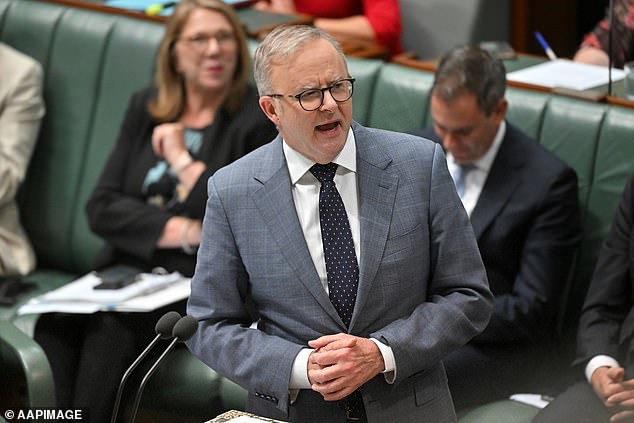- Australian rates higher than New Zealand and Canada
Anthony Albanese’s boasting about Australia’s superior economic position has hurt him again after New Zealand cut its interest rates to make them lower than here.
During the cost of living crisis, Labor has been using the idea that Australia’s 4.35 per cent cash rate is lower than other developed nations that have cut rates this year.
But that argument is weakening after the Reserve Bank of New Zealand on Wednesday cut its cash rate by 50 basis points to 4.25 percent, marking the third cut in 2024.
Just three weeks ago the Prime Minister was boasting that Australia still had lower interest rates than New Zealand.
“We are in difficult global economic times,” Albanese told reporters at Parliament in Canberra.
“This is, you know, interest rates are higher in the United States, New Zealand and the United Kingdom than here.”
Unlike Australia, New Zealand has much lower inflation, as its central bank noted when it announced a half percentage point rate cut.
“Annual consumer price inflation has declined and is now near the midpoint of the Monetary Policy Committee’s target band of one to three per cent,” the Reserve Bank of New Zealand said.
Anthony Albanese’s boasts about Australia’s superior economic position have backfired after New Zealand cut its interest rates to make them lower than here.
New Zealand’s central bank even suggested it would continue cutting interest rates in 2025.
‘Inflation expectations are also close to target and core inflation is converging towards the midpoint. “If economic conditions continue to evolve as anticipated, the committee hopes to be able to further reduce the OCR early next year,” he said.
The RBNZ’s upbeat tone on the overnight rate contrasts sharply with that of the Reserve Bank of Australia, which has hinted at another rate hike by “not ruling out anything coming in or going out.”
During the September quarter, New Zealand’s inflation rate of 2.2 per cent was much lower than Australia’s equivalent level of 2.8 per cent.
Australian borrowers are unlikely to get any relief until next year.
The futures market does not expect the Reserve Bank of Australia to cut rates until May next year, a forecast shared by Westpac and NAB.
Australia’s core inflation rate of 3.5 per cent in October was still above the RBA’s target of 2 to 3 per cent when volatile and one-off prices such as $300 electricity rebates were excluded.
RBA Governor Michele Bullock suggested this month that too much public spending was contributing to inflation.

During the cost of living crisis, Labor has been using the idea that Australia’s 4.35 per cent cash rate is lower than other developed nations that have cut rates this year.
“I must emphasize that it is not just about the federal governments, but also about the state governments,” he said.
“So the fact that we’ve had to revise our public demand forecasts reflects the fact that there have been more announcements and more things are happening.”
But Treasurer Jim Chalmers on Wednesday took advantage of volatile monthly data showing headline inflation rose just 2.1 percent.
“This is another really encouraging sign that our policies are helping to reduce inflation after it was higher and rising under the Liberals,” he said.
“Today’s figures show that monthly inflation has remained in the Reserve Bank’s target band for three consecutive months for the first time in almost five years.”
He left out the fact that the federal government’s $300 electricity rebates caused power prices to fall 35.6 percent over the year, while gasoline prices plummeted 11.5 percent.
The Reserve Bank expects headline inflation, also known as the consumer price index, to rise again to 3.7 per cent by the end of 2025, after Labour’s electricity rebates expire.
New Zealand is far from the only advanced economy with lower interest rates than Australia.
The Bank of Canada’s official interest rate is even lower at 3.75 per cent, having cut rates four times this year.
The European Central Bank has an even lower marginal lending rate of 3.65 percent after three cuts in 2024.
The US Federal Reserve and the Bank of England have cut rates twice in 2024.


